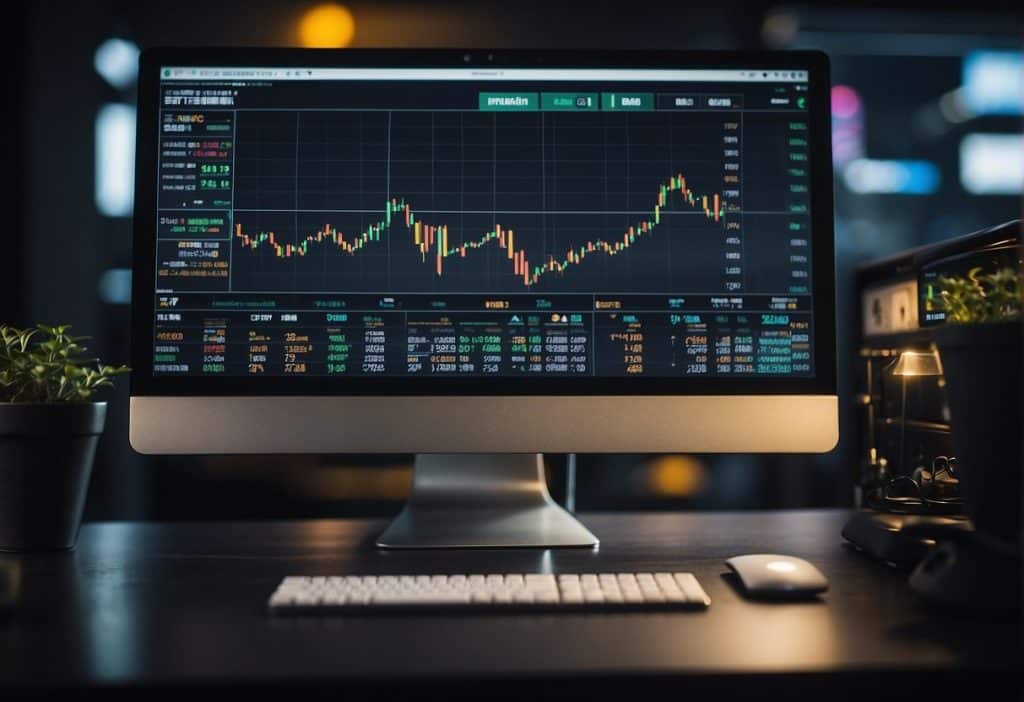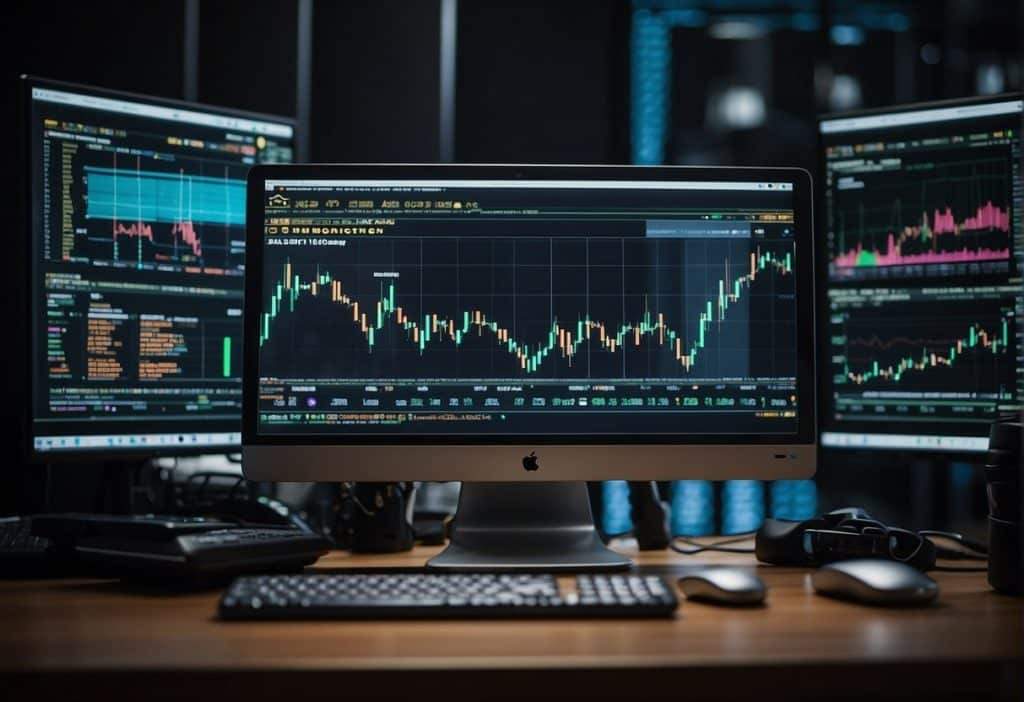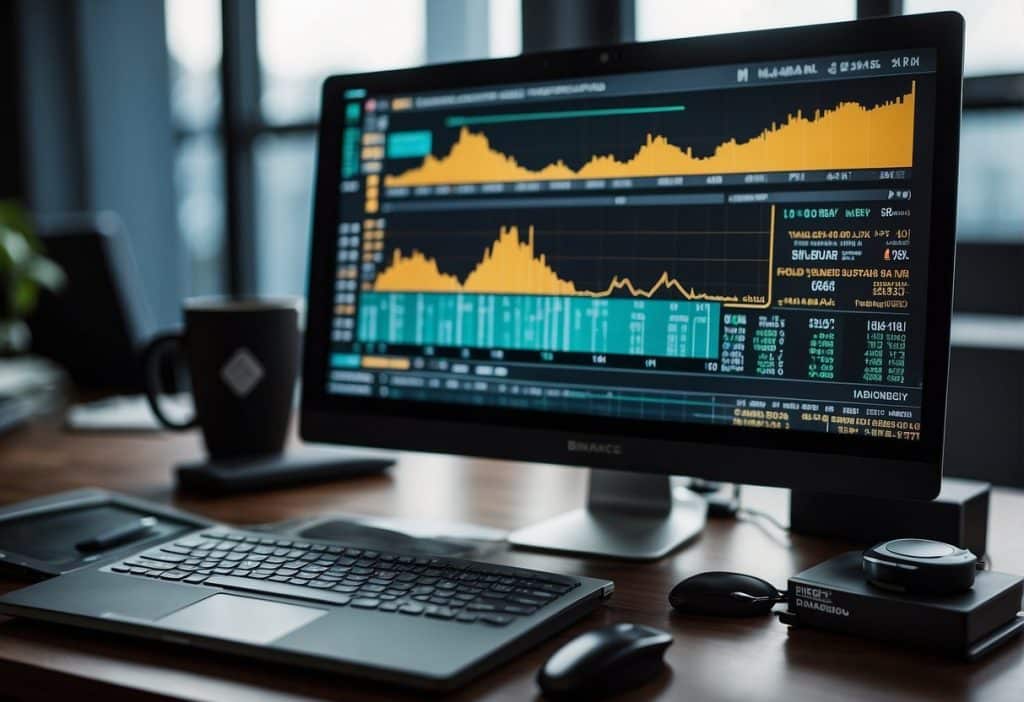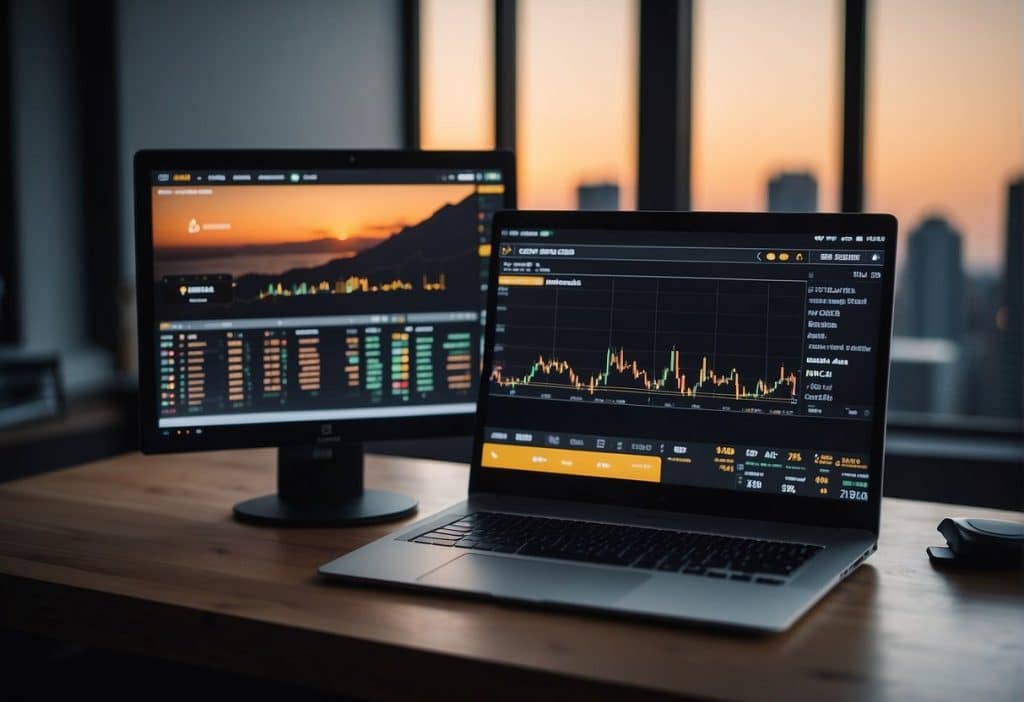Margin trading on Binance allows traders to amplify their trading position by borrowing funds, giving them the capability to operate with more capital than is actually available in their balance. This method enables potentially higher profits but also comes with increased risk, as losses can also be amplified. Binance, being one of the leading cryptocurrency exchanges globally, provides a platform for this advanced trading strategy, catering to more experienced traders who understand the market and its risks.

When you begin margin trading on Binance, you must first open a margin account which is separate from your regular trading account. This margin account allows you to borrow funds to trade larger amounts of cryptocurrencies. Binance offers insurance funds to protect your account when your equity is under threat, ensuring a level of risk management. However, it is crucial that you grasp the workings and implications of leveraging and margin calls before engaging in margin trading.
Key Takeaways
- Margin trading on Binance amplifies trading power through borrowed capital.
- A dedicated margin account is required to start margin trading.
- Binance provides risk management features like insurance funds.
NOT YET A BINANCE USER?
Join today with the Binance Referral Code for exclusive benefits or read our Binance Review to learn why Binance is the right exchange for you!
GET UP TO 50% OFF TRADING FEES WITH THE CODE “WUPBLUYN”
Understanding Margin Trading
Margin trading on Binance allows you to amplify your trading capacity through leverage. By understanding the essentials of margin trading, you can harness its potential on Binance’s platform.
Defining Margin Trading
Margin trading is a powerful tool that enables you to trade assets by borrowing funds, enhancing your investment capacity beyond your initial capital. This means you can potentially gain larger profits from successful trades. However, it’s crucial to remember that while the prospects of higher returns are tempting, margin trading also comes with an increased risk of losses.
Margin Trading on Binance
Binance, one of the world’s leading cryptocurrency exchanges, provides a robust platform for margin trading. It allows you to borrow funds to trade, thereby increasing your buying power. When you trade on margin with Binance, you’ll need to open a specialized margin account which is separate from your ordinary trading account.
Margin Trading Account vs. Regular Account:
| Feature | Margin Account | Regular Account |
|---|---|---|
| Trading Capacity | Increased with borrowed funds | Limited to owned capital |
| Potential for Profit | Higher due to leverage | Limited to owned capital |
| Risk Level | Higher, as losses can exceed deposits | Limited to the value of owned assets |
Binance Margin Trading Page
The Binance margin trading page provides a user-friendly interface (UI), making it simple to navigate through the complexities of margin trading. It includes tools and guides to help you set up and manage your margin account. The UI layout is designed to display all necessary information and actions required for margin trading, such as your borrowing limit and current positions.
Starting with Margin Trading
Margin trading on Binance allows you to access greater capital through borrowing, increasing your investment potential. Before getting started, it’s crucial to understand the key components, including the creation of a margin account, transferring assets, borrowing funds, and knowing the trading pairs to trade effectively.
Creating a Margin Account
To begin margin trading, you need to set up a Margin Account on Binance. Navigate to the ‘Wallet’ tab and select ‘Margin Wallet’. Accept the Margin Account Terms of Service to activate your account.
Transfer Assets to Margin Wallet
Once your Margin Account is active, transfer assets from your primary Binance wallet to your Margin Wallet. This transfer is an essential step as the assets in your Margin Wallet are used as collateral for borrowing funds.
To transfer assets:
- Click ‘Transfer’ on the Margin Wallet page.
- Select the asset and the amount you wish to transfer.
- Confirm the transaction.
Borrowing Funds for Trading
With assets in your Margin Wallet, you can borrow funds to trade. The maximum amount you can borrow depends on your collateral (assets in Margin Wallet) and the Margin Level.
To borrow funds:
- Click ‘Borrow/Repay’ in your Margin Wallet.
- Choose the asset you want to borrow.
- Enter the amount and confirm the loan.
Remember, borrowing increases potential profits as well as potential losses.
Understanding Trading Pairs
Trading pairs on Binance’s margin trading platform consist of two currencies that can be traded for one another. The first currency in the pair is the base currency, and the second is the quote currency.
Commonly traded pairs for margin trading include:
- BTC/USDT (Bitcoin/Tether)
- ETH/BTC (Ethereum/Bitcoin)
Choose trading pairs wisely as they determine the market you’re entering and the strategies you can employ.
Margin Trading Mechanics

In this section, we’ll explore the mechanics of margin trading on Binance, focusing on how leverage works, how to manage your positions to maximize potential profits or minimize losses, and the types of orders you can place.
The Role of Leverage
Leverage is a pivotal aspect of margin trading, allowing you to borrow funds to increase your trading position beyond what would be possible with your current account balance. On Binance, leverage ratios might range from 3x for a regular account to as much as 10x for isolated margin trading. When trading pairs like BTC/USDT or BNB/ETH, leveraging can amplify both profits and losses, so it’s crucial to use it thoughtfully.
Managing Positions
To manage your positions effectively, you should closely monitor market movements and ensure that your account has sufficient margin to avoid liquidation. Liquidation occurs when your position value depreciates to a level where your account balance can no longer sustain the borrowed amount. Proper position management involves knowing when to enter and exit trades and react to price fluctuations in BTC, USDT, ETH, and BNB, which aims to optimize your outcomes.
Order Types Used in Margin Trading
Binance supports several order types which you can use to enter and manage positions in margin trading. The primary order types include:
- Market Orders: These orders execute immediately at the current market price.
- Limit Orders: You can set a specific price at which your order will be executed.
- Stop-Limit Orders: This type of order helps to limit losses by setting a stop price and a limit price.
- OCO (One-Cancels-the-Other) Orders: A pair of orders stipulating that, if one order is executed, the other is automatically canceled.
Here is a comparison of how these order types function:
| Order Type | Description | Use Case |
|---|---|---|
| Market Order | Executes immediately at market price | Fast entry or exit from a position |
| Limit Order | Sets the specific price for execution | Buying/Selling at predetermined prices |
| Stop-Limit Order | Set stop and limit prices for execution | Limiting potential losses |
| OCO Order | Pairs two orders together, executing one cancels the other | Simultaneous profit target and stop-loss |
Using these order types strategically can result in more effective trading on Binance’s margin trading platform. Remember, it is essential to understand the risks associated with leverage and order types to navigate margin trading successfully.
Risk and Protection

In margin trading, understanding the mechanics of liquidation, risk management strategies, maintaining margin levels, and learning about the insurance fund and cooling-off periods are critical to safeguarding your investments on Binance.
Understanding Liquidation
When your margin level falls below the maintenance margin, liquidation occurs. This is a forced closure of your positions to prevent further losses that might exceed your account balance. Here’s what happens:
- Initial Risk Ratio: Determines the starting level at which your trade is entered.
- Margin Call Ratio: The point at which you’ll get a warning to add more funds.
- Liquidation Ratio: If your margin level drops to this ratio, your position will be liquidated.
Risk Management Strategies
Effective risk management is vital to protect your assets. You should:
- Set stop-loss orders to minimize potential losses.
- Only trade with amounts you can afford to lose to combat excessive trading.
- Understand and apply diversification to spread risk across different assets.
Maintaining Margin Levels
Keep a close eye on your Margin Level, which is the metric indicating the health of your open positions. To maintain a healthy margin level:
- Monitor your investments regularly.
- Ensure to add funds to avoid margin calls and potential liquidation.
Insurance Fund and Cooling-Off Period
Insurance Fund: Binance has a risk fund to protect investors from total capital loss if liquidations exceed an account’s balance.
Cooling-Off Period: To curb excessive trading, Binance offers a voluntary feature where you can take a break from trading for a set period. This helps you avoid making impulsive, high-risk trades.
Understanding these elements helps you trade with confidence while managing the inherent risks of margin trading.
Financial Components of Margin Trading

Margin trading on platforms like Binance amplifies your trading power by allowing you to borrow funds, but it involves specific financial components you should be aware of, such as interest rates, capital requirements, and the methods used to calculate profits and losses.
Interest Rates and Fees
When you engage in margin trading, you borrow capital from Binance to increase your buying potential. This borrowed capital comes with an interest rate, which is the cost you incur over time for using the additional funds. Additionally, trading fees are charged per transaction, and these can vary based on the type of order executed and the current transaction rates.
Interest Rates: Varies depending on market conditions and loan duration. Trading Fees: Consists of an order fee for placing trades and may include other operational fees.
Equity and Capital
Your equity refers to the value of your account minus any borrowed funds, essentially representing your stake in the trading position. Your capital is the total amount of funds you have deposited into your account, which must meet the minimum equity requirement set by Binance to maintain your margin positions.
- Minimum Equity Requirement: The required threshold you must meet to avoid a margin call.
- Maintenance Margin: The minimum amount of capital you must maintain to keep the position open.
Assessing Profits and Losses
To assess your profits and losses (P&L) from margin trading activities, you need to account for the borrowed funds as well as any fees or interest paid. Your P&L is realized when you close a position and is calculated by subtracting the purchase price and associated costs from the selling price.
Example P&L Calculation:
- Selling Price: Price at which you sell the asset
- Purchase Price: Price at which you bought the asset
- Fees & Interest: Sum of all trading fees and interest paid on borrowed funds
- Net P&L: (Selling Price – Purchase Price) – Fees & Interest
Types of Margin Trading Accounts

Before delving into the specifics of each margin trading account, it’s essential for you to understand that Binance provides two primary types of accounts: Cross Margin Trading and Isolated Margin Trading. Each has unique features that cater to different trading strategies and risk management preferences.
Cross Margin Trading
Cross Margin Trading allows you to utilize all your assets in the margin account as collateral. This type of account supports you by providing more funds, thus enhancing your buying power across multiple positions. Cross account transfers enable you to reallocate funds seamlessly to manage your positions effectively. However, the risk is spread out across all your positions: if one trade goes poorly, it may affect your entire portfolio.
Isolated Margin Trading
With Isolated Margin Trading, the margin is independent for each trading pair, meaning it’s applied to separate positions individually. You can select the amount of leverage you wish to use with precision for every position, allowing for fine-tuned risk management. Isolated & Cross Account Transfer is possible, enabling you to move funds between the two types of accounts. However, in isolated margin, if a position fails to meet the margin requirements, only that particular position is liquidated, protecting your other assets.
Differences Between Isolated Margin and Cross Margin
Understanding the differences between these two types of margin accounts is crucial for effective risk management. Here’s a comparison to help you grasp the core distinctions:
| Criteria | Cross Margin | Isolated Margin |
|---|---|---|
| Risk Spreading | Distributed across all positions, higher overall account risk. | Contained within a single position, reducing overall account risk. |
| Leverage Adjustment | Collective for the entire account, cannot adjust for individual positions. | Can be adjusted per position, enabling finer control. |
| Position Liquidation | If one position fails, it can impact the whole account leading to multiple liquidations. | If a position fails, only that specific one is liquidated, the other positions remain unaffected. |
| Account Transfer | Cross account transfer lets you move assets within the same margin account type. | Isolated & Cross account transfer allows for moving assets between different account types. |
This comparison should equip you with a clear understanding of how each account type operates and the implications they have for your trading activities. Remember to choose the type that aligns with your trading strategy and risk tolerance levels.
Advanced Margin Trading Topics
In this section, you’ll explore sophisticated strategies and understandings that are crucial for successful margin trading on Binance. Learn how to strategically use collateral, comprehend the intricacies of margin account agreements, and grasp the factors that influence your trading results.
Strategic Use of Collateral and Borrowing
To optimize your trades, it’s imperative to understand the strategic use of collateral. The collateral you provide is the backbone of your borrowing capacity. Binance allows a variety of assets as collateral, with different assets offering varied borrowing power.
- BTC, ETH: High borrowing power
- Altcoins: Varying borrowing power depending on volatility and market liquidity
Using collateral effectively amplifies trading results by enabling larger positions than your cash balance would allow. However, it also introduces higher risks, as adverse market moves can lead to margin calls or liquidation.
Margin Account Agreement and Terms
Margin Account Agreements outline the obligations between you and Binance when engaging in margin trading. These agreements include terms such as interest rates for borrowed funds and the procedure for liquidation in case of a margin call. It is essential that you read and understand these terms:
- Interest rates vary based on the asset and market conditions.
- Liquidation occurs if your margin level falls below a predetermined threshold.
Binance provides a safety buffer to prevent immediate liquidation, but it’s pivotal to manage your risk to avoid reaching this point.
Factors Influencing Margin Trading Results
Several key factors impact your success in margin trading:
- Market Volatility
- High volatility can lead to rapid gains or losses.
- Knowledge of Market Trends
- Understanding the direction and strength of market trends can guide better decision-making.
- Risk Management Strategies
- Effective use of stop-loss orders and monitoring open positions.
Remember, while margin trading on Binance amplifies trading results, it can also amplify losses. Continuous learning and adapting are essential to navigate the complexities of advanced margin trading.
Binance Margin Trading Features
Binance Margin Trading enhances your trading capabilities by allowing you to borrow funds and engage in spot trading with cryptocurrencies. It offers advanced features designed for both new and seasoned traders seeking leverage and flexible trading options.
Binance Futures Integration
Your Binance Margin Trading Account is seamlessly integrated with Binance Futures. This allows you to diversify your trading strategies and have access to high liquidity markets. The futures wallet feature enables you to easily transfer funds between your margin and futures accounts, ensuring you can manage your positions efficiently to mitigate liquidation risk.
Advanced Security and Reliability
When you engage in margin trading with Binance, you benefit from reliable security measures to protect your funds. Binance uses an advanced risk management system and a secure asset fund for users (SAFU), which acts as a risk fund to mitigate exceptional losses. This results in a highly reliable platform that lets you trade with confidence, knowing that measures are in place to safeguard your assets.
Flexible Trading Options
Binance offers flexibility in margin trading with the choice between cross margin and isolated margin modes. Here’s how they compare:
| Margin Mode | Description |
|---|---|
| Cross Margin | Shared balance across all positions, reducing the risk of individual liquidations but potentially increasing overall liquidation risk. |
| Isolated Margin | Specific balance for individual positions, allowing for precise control of risk and prevention of spill-over effects from one position to another. |
This flexibility allows you to tailor your trading approach to your comfort with risk and your specific trading strategy. Throughout your trading experience, you’ll have the opportunity to trade a wide range of cryptocurrencies, further enhancing your ability to respond to market movements and opportunities.
Considerations for Responsible Trading
Responsible trading on Binance, especially within the realm of margin trading, requires a multifaceted approach. Key considerations include enhancing your understanding, assessing market conditions carefully, and maintaining a disciplined approach to trading frequency.
The Importance of Education
Educating yourself before engaging in margin trading is crucial. As you are trading with borrowed funds, it’s essential to understand the specific features and rules of Binance margin accounts. Prioritize gaining knowledge on order types, associated fees, and risk management tools available on the platform. Remember:
- Education: Before starting, complete any pre-trading knowledge Binance requires.
- Risk Management: Utilize tools like stop-loss orders to protect your positions.
Evaluating Market Volatility
Market volatility can significantly impact the performance of your trades, especially when leveraging borrowed funds. Being aware of current market conditions and historical volatility can help you make more informed decisions. Consider:
- Historical Trends: Look at past price fluctuations of the assets you’re interested in.
- Current News: Stay updated with the latest market news that may cause price volatility.
Avoiding Excessive Trading
Excessive trading can lead to hastily made decisions and amplify your risks when trading on margin. It’s important to:
- Establish trading limits for yourself to prevent overexposure.
- Take breaks if you notice you’re making frequent, impulsive trades (Binance offers cooling-off periods).
By focusing on education, correctly evaluating volatility, and avoiding excessive trading, you enhance your ability to trade responsibly on Binance. Remember to always trade within your means and continuously reassess your strategies in response to market changes.
Summing Up Binance Margin Trading
Binance Margin Trading allows you to leverage digital assets for potential profits but involves higher risks. Your trading accounts can control more funds than you own, which amplifies both gains and losses.
Pros and Cons of Margin Trading
Pros:
- Increased Buying Power: You can control a larger position with less capital.
- Potential for Greater Profits: Trading on margin can amplify your profits if the market moves in your favor.
Cons:
- Higher Risk: Losses can exceed your initial investment.
- Interest Costs: Borrowing funds incurs interest that can reduce net gains.
| Pros | Cons | |
|---|---|---|
| Buying Power | You amplify your trading capacity | Potential losses could outstrip your capital |
| Profit Potential | Gains are magnified on successful trades | Markets moving against you can lead to amplified losses |
| Interest Costs | – | Paying interest on borrowed funds can impact profitability |
Concluding Thoughts
Margin trading on Binance offers a sophisticated toolset for experienced traders who understand the risks and management strategies. It’s an opportunity to enhance profits using the world’s largest cryptocurrency exchange by volume but requires a solid risk management plan.
Frequently Asked Questions
Margin trading on Binance allows you to access greater sums of capital, amplifying your trading power. Here are some of the most common questions and clear, concise answers to assist you in navigating margin trading on Binance.
What are the fees associated with margin trading on Binance?
When trading on margin with Binance, you’ll incur a marginal fee for the borrowed funds. This fee varies depending on the asset and must be considered as it can affect your trading profitability.
How does one calculate margin interest on Binance?
Margin interest on Binance is calculated hourly and depends on the amount borrowed and the lending rate at the time of the trade. To avoid surprises, regularly check the current rates for the assets you are trading.
What is the difference between margin trading and futures trading on Binance?
Margin trading involves borrowing funds to increase your trading position, requiring you to pay back with interest. Futures trading, on the other hand, allows you to speculate on the future price of assets, often involving higher risks and no requirement to pay back borrowed funds.
What are the margin requirements for trading on Binance?
The margin requirements on Binance include maintaining a minimum amount of equity to keep your positions open. If your account value falls below this threshold, known as the Maintenance Margin Requirement (MMR), you may be subject to a margin call or forced liquidation.
How does the margin leverage function work on Binance?
Margin leverage on Binance enhances your buying power by allowing you to borrow funds to increase potential profits. However, it also increases potential losses, so it’s imperative to understand the risks and use leverage prudently.
How can a trader set a take profit order when margin trading on Binance?
To set a take profit order when margin trading on Binance, select the desired asset, enter the target price where you’d like to take profits, and the system will execute the sale once the market reaches that price, assuming there is sufficient liquidity.
